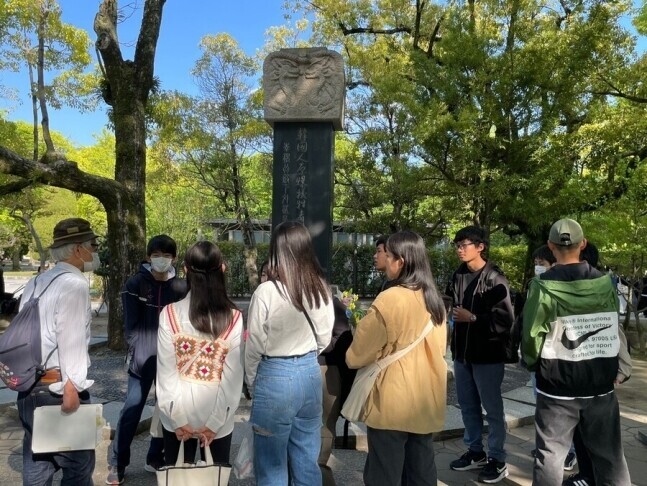hankyoreh
Links to other country sites 다른 나라 사이트 링크
Japanese PM’s plan to visit Hiroshima memorial to Korean A-bomb victims welcomed by victims

Japanese Prime Minister Fumio Kishida announced on Sunday that he would visit the memorial to Korean victims of the atomic bomb at the Hiroshima Peace Memorial Park, a gesture that is being welcomed by victims. Kishida will become the second sitting prime minister of Japan to visit the memorial after Keizo Obuchi did so in 1999.
“I am very surprised and pleased that the leaders of South Korea and Japan will come to the memorial to pay their respects,” said Kwon Jun-o, vice chairperson of a special committee for atomic bomb victims in the Hiroshima office of the Korean Residents Union in Japan, speaking to the Hankyoreh.
“I would be even happier if the two leaders also pledged to abolish nuclear weapons,” he added.
Etsuko Nakatani, 73, the president of the Hiroshima branch of the Citizens’ Association for the Relief of A-bomb Victims in South Korea, which supports Korean victims of the bombing, had earlier told Hankyoreh that she hoped the leaders of South Korea and Japan would meet in Hiroshima to discuss the issue of atomic bomb victims.
The prime minister’s decision to visit the memorial has fulfilled the long-time wish of Korean victims of the bombing of Hiroshima.
Kishida was able to make this decision because his home and political roots are in Hiroshima. Representing the most liberal faction of the Liberal Democratic Party (the Kochi faction), Kishida’s greatest political asset could be said to be his determination to realize a world without nuclear weapons.
This is why he chose Hiroshima as the venue for the Group of Seven summit, which will take place on May 19-21. In addition, the idea of visiting the Korean atomic bomb victims is bound to be met with less resistance from the Japanese public than other issues related to Japan’s past, due to the nation’s identity as the only country to have ever had an atomic bomb dropped on it.
The memorial to Korean atomic bomb victims at the site dates back to 1967. A group of Hiroshima-based Koreans, led by atomic bomb victims and the Korean Residents Union in Japan (Mindan), pushed for a memorial to Korean victims of the bombing to be erected inside the Hiroshima Peace Memorial Park.
After initially responding positively, the city of Hiroshima said it could not allow the memorial to be built in the park, forcing the Korean residents to erect the memorial off park grounds. In May 1999, the monument was moved to its current location in the park thanks to the efforts of Japanese civil society to remember the victims of the bombing.
The inscription reads, “At the end of World War II there were about 100,000 Koreans living in Hiroshima as soldiers, civilian employees of the army, mobilized students and ordinary citizens. When the atomic bomb was dropped on August 6th, 1945, the sacred lives of more than 20,000 Koreans were suddenly taken from our midst.”
It is estimated that 30,000 people from the Korean Peninsula (North and South Korea combined) were killed in Hiroshima, which accounts for 10 percent of the total victims of the bombing.
By Kim So-youn, Tokyo correspondent
Please direct questions or comments to [english@hani.co.kr]

Editorial・opinion
![[Column] Season 2 of special prosecutor probe may be coming to Korea soon [Column] Season 2 of special prosecutor probe may be coming to Korea soon](https://flexible.img.hani.co.kr/flexible/normal/500/300/imgdb/original/2024/0426/3317141030699447.jpg) [Column] Season 2 of special prosecutor probe may be coming to Korea soon
[Column] Season 2 of special prosecutor probe may be coming to Korea soon![[Column] Park Geun-hye déjà vu in Yoon Suk-yeol [Column] Park Geun-hye déjà vu in Yoon Suk-yeol](https://flexible.img.hani.co.kr/flexible/normal/500/300/imgdb/original/2024/0424/651713945113788.jpg) [Column] Park Geun-hye déjà vu in Yoon Suk-yeol
[Column] Park Geun-hye déjà vu in Yoon Suk-yeol- [Editorial] New weight of N. Korea’s nuclear threats makes dialogue all the more urgent
- [Guest essay] The real reason Korea’s new right wants to dub Rhee a founding father
- [Column] ‘Choson’: Is it time we start referring to N. Korea in its own terms?
- [Editorial] Japan’s rewriting of history with Korea has gone too far
- [Column] The president’s questionable capacity for dialogue
- [Column] Are chaebol firms just pizza pies for families to divvy up as they please?
- [Column] Has Korea, too, crossed the Rubicon on China?
- [Correspondent’s column] In Japan’s alliance with US, echoes of its past alliances with UK
Most viewed articles
- 1AI is catching up with humans at a ‘shocking’ rate
- 2Korea’s 1.3% growth in Q1 signals ‘textbook’ return to growth, says government
- 3[Column] Park Geun-hye déjà vu in Yoon Suk-yeol
- 4No good, very bad game for Korea puts it out of Olympics for first time since 1988
- 5[Column] Season 2 of special prosecutor probe may be coming to Korea soon
- 6[Column] Has Korea, too, crossed the Rubicon on China?
- 7Division commander ordered troops to enter raging flood waters before Marine died, survivor says
- 8Is Japan about to snatch control of Line messenger from Korea’s Naver?
- 9Marriages nosedived 40% over last 10 years in Korea, a factor in low birth rate
- 101 in 5 unwed Korean women want child-free life, study shows